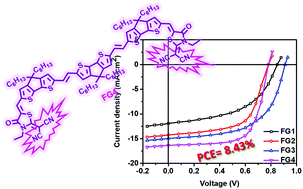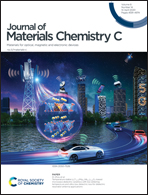The influence of the terminal acceptor and oligomer length on the photovoltaic properties of A–D–A small molecule donors†
Abstract
Four new A–D–A small molecules (denoted as FG1–4) have been designed and synthesized. The compounds have cyclopentadithiophene-vinylene (CPDTV) oligomers of different lengths as the central donor core linked with different terminal acceptor units (3-ethylrhodanine or dicyanomethylene-3-ethylrhodanine). The effects that conjugation length and terminal acceptor units have on the optical and electrochemical properties were investigated. These small molecules were used as donors in conjunction with PC71BM as an acceptor in the bulk heterojunction active layer for the fabrication of solution-processed organic solar cells. Solvent vapor annealing treatment improved the crystallinity and the interpenetrating networks of donor and acceptor phases for exciton dissociation and charge transfer, thus leading to significant improvements in the overall power conversion efficiency (PCE) of the organic solar cells. The PCE values for the organic solar cells based on the optimized FG1:PC71BM, FG2:PC71BM, FG3:PC71BM and FG4:PC71BM active layer were 5.58%, 6.99%, 7.51% and 8.43%, respectively. These results indicate that an enhancement in the PCE of small molecule organic solar cells can be achieved by an increase in conjugation-length and variation of terminal acceptor units in the molecular backbone of small molecules and optimization of the crystallinity and nanoscale interpenetrating morphology by appropriate solvent vapor annealing treatment.



 Please wait while we load your content...
Please wait while we load your content...